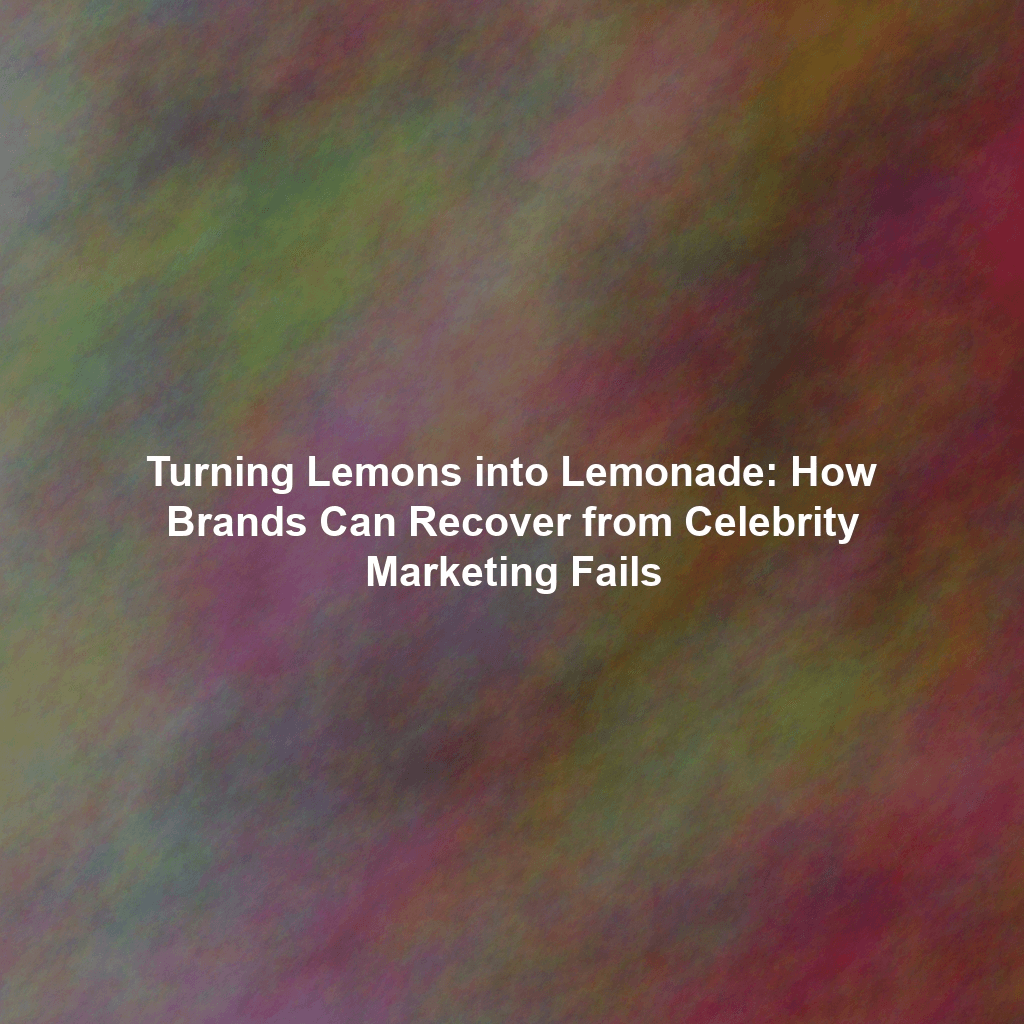Celebrity endorsements can be a goldmine for brands, catapulting sales and boosting brand awareness. But what happens when that golden goose lays a rotten egg? A celebrity’s misstep – whether it’s a controversial statement, a public scandal, or simply a perceived lack of authenticity – can quickly turn a lucrative partnership into a PR nightmare. The good news is, not all celebrity marketing fails are fatal. With the right strategy, brands can navigate the fallout, mitigate the damage, and even emerge stronger than before. This article explores how to turn those lemons into lemonade, providing a roadmap for recovery.
The Anatomy of a Celebrity Marketing Disaster
Before diving into recovery strategies, it’s crucial to understand the different ways a celebrity endorsement can go wrong. These failures can range from minor blips to major crises that threaten a brand’s reputation.
Types of Celebrity Marketing Fails
- Controversies and Scandals: This is perhaps the most obvious type of failure. A celebrity embroiled in legal troubles, political scandals, or ethical breaches can instantly tarnish the brand they represent.
- Lack of Authenticity: Consumers are increasingly savvy and can spot a forced endorsement from a mile away. If a celebrity seems disengaged or doesn’t genuinely use or believe in the product, the partnership can backfire.
- Overexposure: A celebrity endorsing too many brands at once can dilute their credibility and diminish the impact of any single endorsement. Consumers may perceive the celebrity as simply chasing a paycheck.
- Brand Misalignment: Choosing a celebrity whose values or public image clash with the brand’s core values can create dissonance and alienate the target audience.
- Social Media Missteps: A celebrity’s ill-advised tweet, offensive post, or insensitive comment on social media can trigger immediate backlash and damage both their reputation and the brand they represent.
The Recovery Roadmap: Steps to Take After a PR Crisis
When a celebrity endorsement turns sour, swift and decisive action is essential. Here’s a step-by-step guide to navigate the crisis and begin the recovery process:
1. Immediate Action: Acknowledge and Assess
The first step is to acknowledge the situation promptly. Silence is often interpreted as complicity or indifference. Form a crisis communication team, gather all the facts, and assess the potential impact on the brand. Monitor social media and media coverage to gauge public sentiment.
2. Craft a Sincere Apology (If Necessary)
Depending on the nature of the celebrity’s misstep, a sincere apology may be warranted. This apology should express empathy for those who were offended, acknowledge the brand’s responsibility, and outline steps being taken to address the situation. Avoid making excuses or shifting blame.
3. Take Corrective Action: Suspension or Termination
Decide whether to suspend or terminate the relationship with the celebrity. This decision will depend on the severity of the offense, the terms of the contract, and the potential long-term impact on the brand. Terminating the relationship sends a clear message that the brand does not condone the celebrity’s actions.
4. Communicate Transparently
Keep stakeholders – including customers, employees, and investors – informed throughout the recovery process. Be transparent about the steps being taken to address the situation and reassure them that the brand is committed to its values.
5. Re-evaluate Your Marketing Strategy
After the immediate crisis has subsided, re-evaluate your marketing strategy. Consider whether celebrity endorsements are still the right approach for your brand, or if alternative strategies, such as influencer marketing with micro-influencers or focusing on user-generated content, might be more effective.
6. Invest in Rebuilding Trust
Rebuilding trust with consumers takes time and effort. Focus on demonstrating the brand’s values through its actions. This could involve supporting relevant causes, engaging in community outreach, or simply providing exceptional customer service.
Examples of Brands that Bounced Back
While every situation is unique, there are examples of brands that have successfully navigated celebrity marketing fails and emerged stronger:
- Nike and Tiger Woods: Despite Woods’s personal scandals, Nike maintained a relationship with him, albeit with adjustments to their marketing strategy. They focused on his athletic achievements and resilience, rather than his personal life. This long-term commitment paid off as Woods successfully rehabilitated his image.
- Dior and Johnny Depp: Despite allegations and legal battles, Dior stood by Johnny Depp and his Sauvage fragrance campaign. This controversial move generated significant media attention and ultimately proved successful, demonstrating that brands can sometimes weather storms by staying true to their chosen partners.
Preventative Measures: Avoiding Future Disasters
Prevention is always better than cure. Here are some steps brands can take to minimize the risk of celebrity marketing fails:
- Thorough Vetting: Conduct thorough background checks on potential celebrity endorsers, paying close attention to their past behavior, social media activity, and public image.
- Detailed Contracts: Include clauses in the contract that protect the brand in the event of a scandal or breach of conduct.
- Clear Guidelines: Provide celebrities with clear guidelines on acceptable behavior and communication, especially on social media.
- Ongoing Monitoring: Continuously monitor the celebrity’s activities and public image to identify potential risks early on.
- Authenticity Checks: Ensure the celebrity genuinely connects with the brand and its products. Stage interactions and observe reactions to see if there is a real connection.
Conclusion
Celebrity marketing fails can be daunting, but they don’t have to be the end of the world. By taking swift and decisive action, communicating transparently, and focusing on rebuilding trust, brands can navigate the fallout and emerge stronger. Remember that authenticity, transparency, and a commitment to core values are key to weathering any storm. Ultimately, turning lemons into lemonade requires a proactive approach, a willingness to learn from mistakes, and a dedication to building a lasting and meaningful connection with consumers.
 Skip to content
Skip to content

